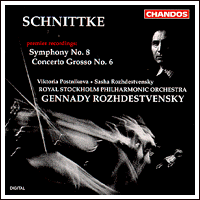
SCHNITTKE
*Concerto Grosso No. 6 (1993)
Symphony No. 8
(1994)
*Sasha Rozhdestvensky, violin
*Victoria Postnikova, piano
Royal Stockholm Philharmonic Orchestra
cond. Gennady Rozhdestvensky
Chandos CHAN 9359 [53:24/DDD]

SCHNITTKE
*Concerto Grosso No. 6 (1993)
Symphony No. 8
(1994)
*Sasha Rozhdestvensky, violin
*Victoria Postnikova, piano
Royal Stockholm Philharmonic Orchestra
cond. Gennady Rozhdestvensky
Chandos CHAN 9359 [53:24/DDD]
Alfred Schnittke's work came into Western fashion by virtue of modernist enthusiasm for his "polystylism", an attribute holding obvious appeal for a culture which stresses surface/structural elements. What was unusual about the modernist West's enthusiasm for Schnittke was that neither craft nor complexity are central to his music - indeed, his scores are often rather baldly, not to say crudely, simple, with orchestration sufficiently indifferent to balance that many loud passages degenerate into indeterminate maelstroms of noise. It was Schnittke's "game-like" juxtapositions that appealed to Western modernists - or, rather, what Western modernists took to be "game-like" juxtapositions. For in Russia, where music is heard in the context of a local culture imbued with symbolism and "intonational" codes, such juxtapositions are seen as anything but "game-like". Gidon Kremer, for instance, rejects the idea that Schnittke is "playing" at anything:
"It's not just a gimmick or a question of parody; it's more a case of provoking something in us, challenging us to look at things differently. Even the 'pleasing' quotations in Schnittke's music could be interpreted as a sort of alarm, warning us of all the nonsense going on around us. Schnittke isn't suggesting that his 'backward glances' recall Good Music and that all the rest is bullshit. He's reminding us that when these older styles existed, we dealt with different values - and that, nowadays, we're in a big mess."That Schnittke is a predominantly serious artist became apparent as more of his music appeared on disc. Indeed, more than merely serious, it began to seem that he was a self-melodramatist harbouring few Western qualms about taste or proportion. After a while, his proclivity for going wildly over the top in every other work started to wear thin with some of his erstwhile Western apologists, and although, at the time of writing (March 1996) nothing as concerted as a Schnittke backlash has emerged, it will surely not be long in arriving. Yet some claim to look deeper. Ronald Weitzmann, for example, who writes the notes to this new Chandos release and who has contributed several pieces on Schnittke to Britain's music magazines, argues that Russians hear this music as primarily religious in inspiration and intention. This, in turn, implies that to reject it for any of the external reasons given above would be to miss its message completely.
If any Schnittke issue can be said to conform to this religious criterion, it is Rozhdestvensky's recording of his two latest instrumental works, the Sixth Concerto Grosso and the Eighth Symphony. Both are clearly symbolic, not to say programmatic, pieces - although the precise nature of what is symbolised here is unspecified. Schnittke's health has been poor for many years and after finishing this symphony, he suffered a stroke (his third) and fell into a coma for three months. He has since recovered and resumed work on his opera Gesualdo (an unfinished version of which was conducted by Rostropovich in Vienna on 26th May 1995). In other words, as was true of the late Allan Pettersson, Schnittke's life is dominated by the pressing issue of mortality. Presumably, then, a central element in the religious symbolism of his current work is the mystery of death.
This would certainly seem to be true of the 18-minute slow movement at the centre of Schnittke's Eighth Symphony. Here, a wistful string cadence recurs in a stark, dark music of ebb and flow, the design and mood of which recalls the late styles of Bruckner, Mahler, and Liszt. The fact that this cadence and a brief chorale for brass (and later for woodwind) are the only fully harmonised tonal elements in an otherwise sparsely atonal design may be symbolic in itself. What this will probably indicate to those unpersuaded of Schnittke's genius is that, ill-equipped to write a real Late Romantic adagio, he can only "suggest" the presence of one by offering a polystylistic postmodern sketch of the real thing. It would be fair to add that Schnittke is at least genuinely in touch with the depth of thought and feeling of his late 19th century models. Indeed, his "suggestion" is forceful enough to show that, given the sensibility and the need, a sufficiently gifted contemporary symphonist might easily compose in something like the style of late Bruckner or Mahler without irony and without sounding anachronistic - on the face of it, a rather damning judgement on the actual symphonism produced by the composers of the 1980s and 1990s.
These works share a skeletal texture and an uncharacteristic refusal to rise very much in volume. Presumably influenced by Schnittke's recent operatic work (Life With An Idiot; Historia von D. Johann Fausten; Gesualdo), their utterances are cryptic and often, apparently, quasi-vocal. Whether those who find the craze for Schnittke a baffling mystery will deem the musical means employed here of any real distinction is doubtful. Collectors who simply enjoy the composer's polystylism in the modernist "game-like" manner will probably be better off with a disc like the New Stockholm Chamber Orchestra's concerto recital [BIS-CD-377]. However, genuine Schnittke devotees may rest assured that this new Chandos release, finely performed and recorded, will provide them with a new, deeper appreciation of this enigmatic composer's mind.